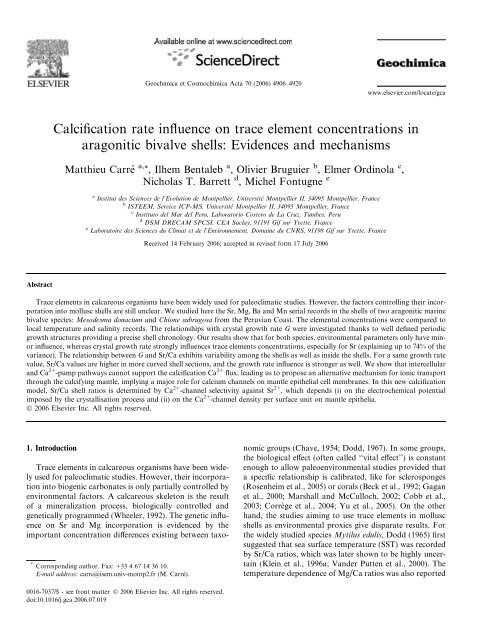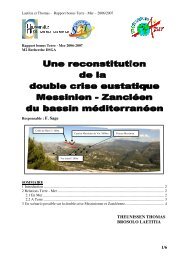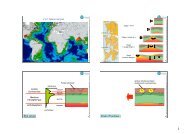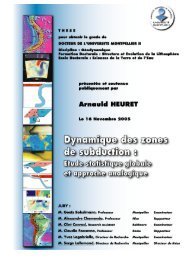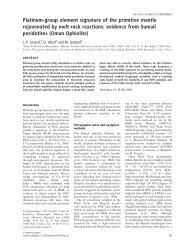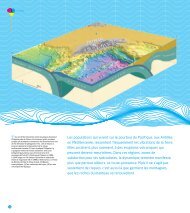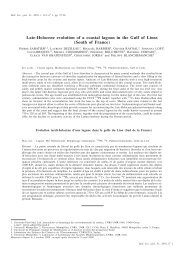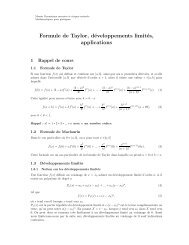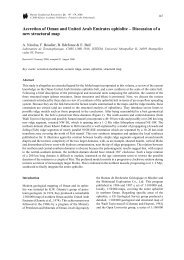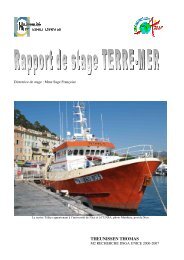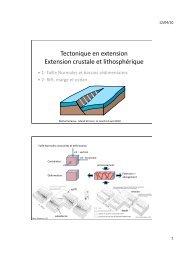Géochronologie U-Pb par ablation laser et ICP-MS (LA-ICP-MS ...
Géochronologie U-Pb par ablation laser et ICP-MS (LA-ICP-MS ...
Géochronologie U-Pb par ablation laser et ICP-MS (LA-ICP-MS ...
You also want an ePaper? Increase the reach of your titles
YUMPU automatically turns print PDFs into web optimized ePapers that Google loves.
Geochimica <strong>et</strong> Cosmochimica Acta 70 (2006) 4906–4920<br />
www.elsevier.com/locate/gca<br />
Calcification rate influence on trace element concentrations in<br />
aragonitic bivalve shells: Evidences and mechanisms<br />
Matthieu Carré a, *, Ilhem Bentaleb a , Olivier Bruguier b , Elmer Ordinola c ,<br />
Nicholas T. Barr<strong>et</strong>t d , Michel Fontugne e<br />
a Institut des Sciences de l’Evolution de Montpellier, Université Montpellier II, 34095 Montpellier, France<br />
b ISTEEM, Service <strong>ICP</strong>-<strong>MS</strong>, Université Montpellier II, 34095 Montpellier, France<br />
c Instituto del Mar del Peru, Laboratorio Costero de La Cruz, Tumbes, Peru<br />
d DSM DRECAM SPCSI, CEA Saclay, 91191 Gif sur Yv<strong>et</strong>te, France<br />
e Laboratoire des Sciences du Climat <strong>et</strong> de l’Environnement, Domaine du CNRS, 91198 Gif sur Yv<strong>et</strong>te, France<br />
Received 14 February 2006; accepted in revised form 17 July 2006<br />
Abstract<br />
Trace elements in calcareous organisms have been widely used for paleoclimatic studies. However, the factors controlling their incorporation<br />
into mollusc shells are still unclear. We studied here the Sr, Mg, Ba and Mn serial records in the shells of two aragonitic marine<br />
bivalve species: Mesodesma donacium and Chione subrugosa from the Peruvian Coast. The elemental concentrations were com<strong>par</strong>ed to<br />
local temperature and salinity records. The relationships with crystal growth rate G were investigated thanks to well defined periodic<br />
growth structures providing a precise shell chronology. Our results show that for both species, environmental <strong>par</strong>am<strong>et</strong>ers only have minor<br />
influence, whereas crystal growth rate strongly influences trace elements concentrations, especially for Sr (explaining up to 74% of the<br />
variance). The relationship b<strong>et</strong>ween G and Sr/Ca exhibits variability among the shells as well as inside the shells. For a same growth rate<br />
value, Sr/Ca values are higher in more curved shell sections, and the growth rate influence is stronger as well. We show that intercellular<br />
and Ca 2+ -pump pathways cannot support the calcification Ca 2+ flux, leading us to propose an alternative mechanism for ionic transport<br />
through the calcifying mantle, implying a major role for calcium channels on mantle epithelial cell membranes. In this new calcification<br />
model, Sr/Ca shell ratios is d<strong>et</strong>ermined by Ca 2+ -channel selectivity against Sr 2+ , which depends (i) on the electrochemical potential<br />
imposed by the crystallisation process and (ii) on the Ca 2+ -channel density per surface unit on mantle epithelia.<br />
Ó 2006 Elsevier Inc. All rights reserved.<br />
1. Introduction<br />
* Corresponding author. Fax: +33 4 67 14 36 10.<br />
E-mail address: carre@isem.univ-montp2.fr (M. Carré).<br />
Trace elements in calcareous organisms have been widely<br />
used for paleoclimatic studies. However, their incorporation<br />
into biogenic carbonates is only <strong>par</strong>tially controlled by<br />
environmental factors. A calcareous skel<strong>et</strong>on is the result<br />
of a mineralization process, biologically controlled and<br />
gen<strong>et</strong>ically programmed (Wheeler, 1992). The gen<strong>et</strong>ic influence<br />
on Sr and Mg incorporation is evidenced by the<br />
important concentration differences existing b<strong>et</strong>ween taxonomic<br />
groups (Chave, 1954; Dodd, 1967). In some groups,<br />
the biological effect (often called ‘‘vital effect’’) is constant<br />
enough to allow paleoenvironmental studies provided that<br />
a specific relationship is calibrated, like for sclerosponges<br />
(Rosenheim <strong>et</strong> al., 2005) or corals (Beck <strong>et</strong> al., 1992; Gagan<br />
<strong>et</strong> al., 2000; Marshall and McCulloch, 2002; Cobb <strong>et</strong> al.,<br />
2003; Corrège <strong>et</strong> al., 2004; Yu <strong>et</strong> al., 2005). On the other<br />
hand, the studies aiming to use trace elements in mollusc<br />
shells as environmental proxies give dis<strong>par</strong>ate results. For<br />
the widely studied species Mytilus edulis, Dodd (1965) first<br />
suggested that sea surface temperature (SST) was recorded<br />
by Sr/Ca ratios, which was later shown to be highly uncertain<br />
(Klein <strong>et</strong> al., 1996a; Vander Putten <strong>et</strong> al., 2000). The<br />
temperature dependence of Mg/Ca ratios was also reported<br />
0016-7037/$ - see front matter Ó 2006 Elsevier Inc. All rights reserved.<br />
doi:10.1016/j.gca.2006.07.019


